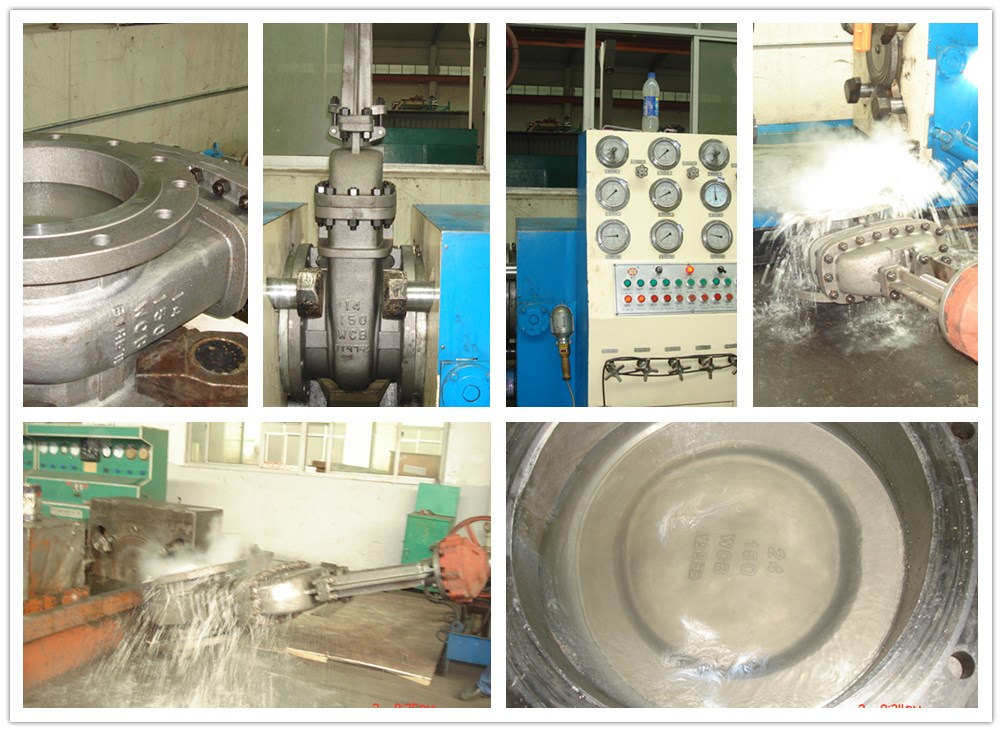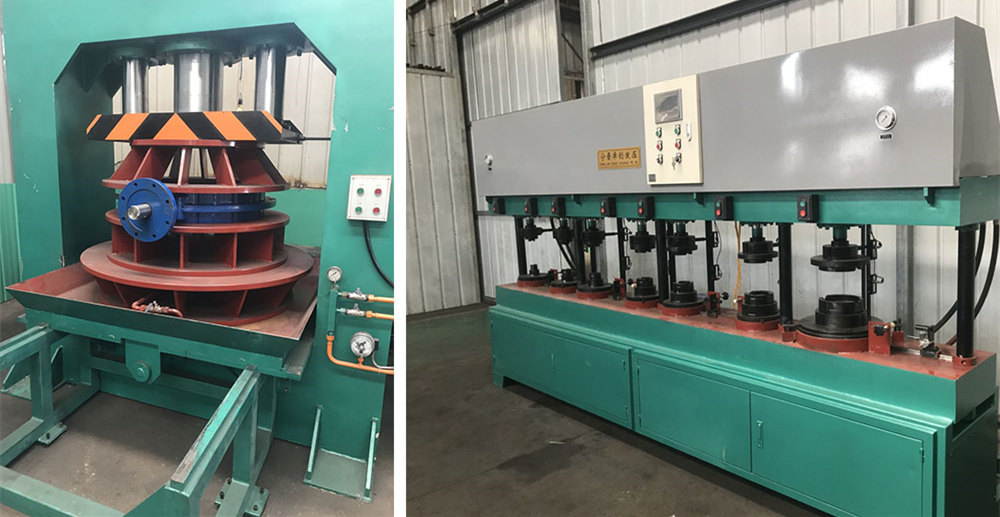In general, the strength test is not carried out when the industrial valve is used, but the strength test should be carried out after the valve body and valve cover are repaired or corroded. For the safety valve, its constant pressure and return pressure and other tests should be in accordance with its instructions and relevant regulations. Valve strength test and valve sealing test should be carried out on valve hydraulic test bench before valve installation. Low pressure valve spot check 20 %, if unqualified should be 100 % inspection ; medium and high pressure valves should be 100 % inspected. The commonly used media for valve pressure test are water, oil, air, steam, nitrogen, etc. The pressure test methods for various industrial valves containing pneumatic valves are as follows :
1. The pressure test method of globe valve and throttle valve
In the strength test of globe valve and throttle valve, the assembled valve is usually placed in the pressure test frame, the valve disc is opened, the medium is injected to the specified value, and check whether the valve body and the valve cover sweat and leakage. Strength test can also be carried out on a single piece.The sealing test is only for the globe valve. During the test, the stem of the globe valve is in a vertical state, the disc is opened, and the medium is introduced from the bottom of the disc to the specified value, and the packing and gasket are checked. After qualified, close the valve disc and open the other end to check for leakage.If both the valve strength and sealing test need to be done, can first do strength test, and then step down to the sealing test specified value, check the packing and gasket ; then close the disc and open the outlet to check whether the sealing surface is leaking.If the valve strength and tightness test are to be done, you can do the strength test first, and then depressurize to the tightness test value, check the packing and gasket; Then close the disc, open the outlet end to check whether the sealing surface leakage.
2. Pressure test method of gate valve
The strength test of gate valve is the same as that of globe valve. There are two ways to test the tightness of gate valves.
(1)The gate opens, so that the pressure inside the valve rises to the specified value; Then close the gate, immediately take out the gate valve, check whether there is leakage in the seal on both sides of the gate or directly inject the test medium into the plug on the valve cover to the specified value, check the seal on both sides of the gate. The above method is called intermediate pressure test. This method is not suitable for the seal test of gate valves with nominal diameter DN32mm below.
(2) The other way is to open the gate, so that the valve test pressure to the specified value; Then close the gate, open one end of the blind plate, check whether the sealing surface leakage. Then reverse, repeat the above test until qualified.
The tightness test at packing and gasket of pneumatic gate valve shall be conducted before the tightness test of gate valve.
3. Ball valve pressure test method
Pneumatic ball valve strength test should be in the ball of ball valve half open state.
(1) Sealing test of floating ball valve : The valve is in a semi-open state, one end is introduced into the test medium, and the other end is closed. Turn the ball several times, open the closed end when the valve is closed, and check the sealing performance of the filler and gasket at the same time, and there should be no leakage. Then the test medium is introduced from the other end to repeat the above test.
(2) The sealing test of the fixed ball valve : the ball is rotated several times without load before the test, and the fixed ball valve is closed, and the test medium is introduced from one end to the specified value ; the pressure gauge is used to check the sealing performance of the inlet end. The accuracy of the pressure gauge is 0.5-1 grade, and the range is 1.6 times of the test pressure. Within the specified time, no step-down phenomenon is qualified ; then the test medium is introduced from the other end to repeat the above test. Then, the valve is in a semi-open state, both ends are closed, the inner cavity is filled with medium, and the filler and gasket are checked under the test pressure without leakage.
(3) Three-way ball valve should be in each position for sealing test.
4. Pressure test method of plug valve
(1) When the strength test of the plug valve is carried out, the medium is introduced from one end, and the other paths are closed. The plug is rotated to each working position of the full opening in turn for the test. And no leakage is found in the valve body.
(2) In the sealing test, the straight-through cock should keep the pressure in the cavity equal to that in the path, rotate the plug to the closed position, check from the other end, and then rotate the plug by 180 ° to repeat the above test. The three-way or four-way plug valve should keep the pressure in the chamber equal to that at one end of the channel, and the plug should be rotated to the closed position in turn. The pressure should be introduced from the right angle end and checked from the other end at the same time.
In front of the plug valve test bench, it is allowed to apply a layer of non-acid dilute lubricating oil on the sealing surface, and no leakage and enlarged water droplets are found within the specified time. Plug valve test time can be shorter, generally according to the nominal diameter of l ~ 3min.
The plug valve for coal gas should be tested for air tightness at 1.25 times the working pressure.
5. Pressure test method of butterfly valve
The strength test of pneumatic butterfly valve is the same as that of globe valve. The sealing performance test of butterfly valve should introduce the test medium from the medium flow end, the butterfly plate should be opened, the other end should be closed, and the injection pressure should be up to the specified value. After checking the packing and other sealing leakage, close the butterfly plate, open the other end, It is qualified to check that there is no leakage in the seal of the butterfly plate.Butterfly valve for regulating flow can not do sealing performance test.
6. Diaphragm valve pressure test method
The diaphragm valve strength test introduces the medium from either end, opens the disc, and the other end is closed. After the test pressure rises to the specified value, it is qualified to see that the valve body and the valve cover have no leakage. Then reduce the pressure to the sealing test pressure, close the disc, open the other end for inspection, no leakage is qualified.
7. Pressure test method of check valve
Check valve test status : lift check valve disc axis in a position perpendicular to the horizontal ; the channel axis and disc axis of the swing check valve are approximately parallel to the horizontal line.
In the strength test, the test medium is introduced from the inlet end to the specified value, and the other end is closed. It is qualified to see that the valve body and the valve cover have no leakage.
The sealing test introduces the test medium from the outlet end, and checks the sealing surface at the inlet end. No leakage at the filler and gasket is qualified.
8. The pressure test method of safety valve
(1) The strength test of the safety valve is the same as that of other valves, which is tested with water. When testing the lower part of the valve body, the pressure is introduced from the inlet I=I end, and the sealing surface is closed; When testing body upper and bonnet, pressure is introduced from the exit El end and other ends are closed. The valve body and bonnet shall be qualified without leakage within the specified time.
(2) Tightness test and constant pressure test, the common medium used is: steam safety valve with saturated steam as the test medium; Ammonia or other gas valve with air as the test medium; The valve for water and other non-corrosive liquids uses water as the test medium. For some important positions of the safety valve commonly used nitrogen as the test medium.
Seal test with nominal pressure value as the test pressure test, the number of times is not less than two times, in the specified time no leakage is qualified. There are two methods of leakage detection: one is to seal the connection of the safety valve, and paste the tissue paper with butter on the flange of the El, the tissue paper bulging for leakage, not bulging for qualified; The second is to use butter to seal the thin plastic plate or other plates in the lower part of the outlet flange, filling water to seal the valve disc, and checking that the water is not bubbling. The test times of constant pressure and return pressure of safety valve shall be no less than 3 times.
9. Pressure test method of pressure reducing valve
(1) The strength test of the pressure reducing valve is generally assembled after a single test, or after assembly. Duration of strength test: DN<50mm 1min; Dn65-150mm longer than 2min; The DN>150mm was longer than 3 min.
After the bellows and components are welded, 1.5 times of the highest pressure after the pressure reducing valve is applied, and the strength test is carried out with air.
(2)The tightness test is carried out according to the actual working medium. When testing with air or water, the test shall be conducted at 1.1 times the nominal pressure; The steam test shall be carried out at the maximum allowable working pressure at the operating temperature. The difference between the inlet pressure and the outlet pressure shall not be less than 0.2MPa. The test method is: after the inlet pressure is set, the adjusting screw of the valve is gradually adjusted, so that the outlet pressure can change sensitively and continuously within the maximum and minimum value range, and there shall be no stagnation and blocking phenomenon. For the steam reducing valve, when the inlet pressure is removed, close the cut-off valve behind the valve, and the outlet pressure is the highest and lowest value. Within 2min, the appreciation of the outlet pressure should meet the relevant requirements. At the same time, the pipeline volume behind the valve is qualified in line with the required requirements. For water and air reducing valves, when the inlet pressure is set and the outlet pressure is zero, the reducing valve is closed for sealing test. It is qualified if there is no leakage within 2 minutes.
Post time: Feb-08-2023


